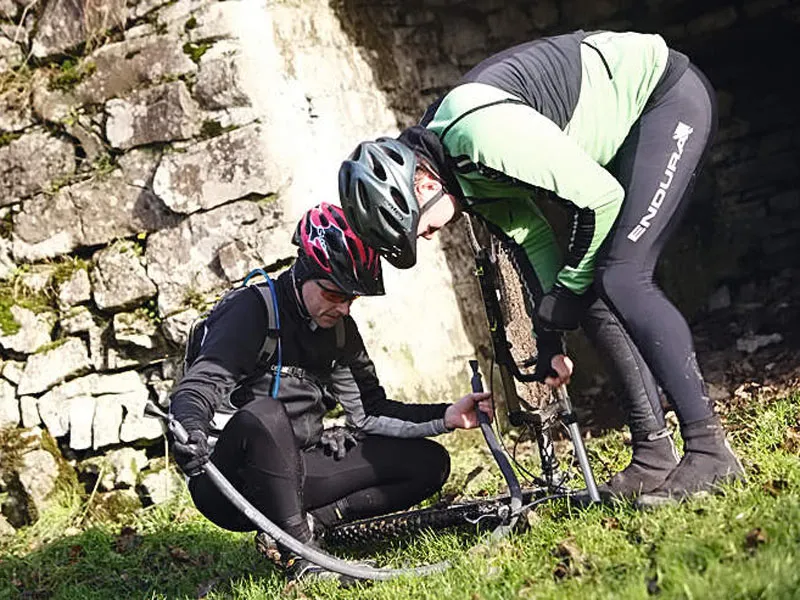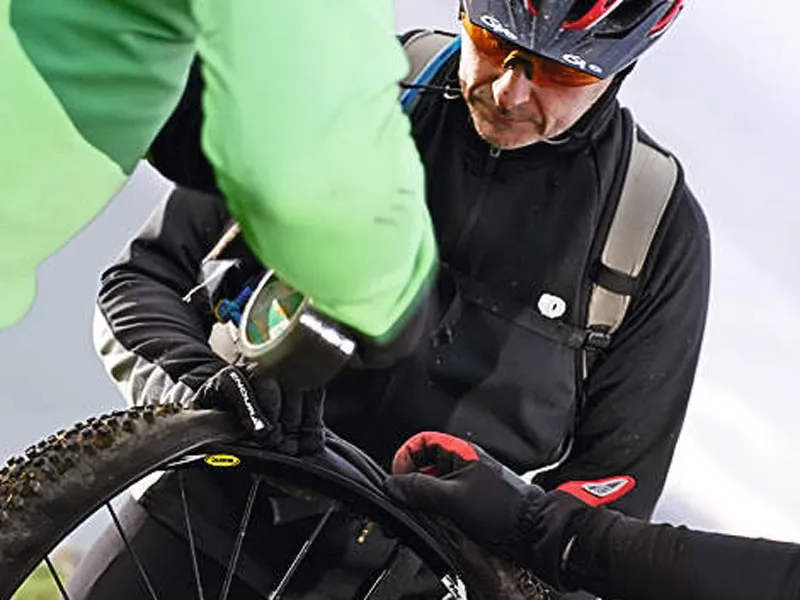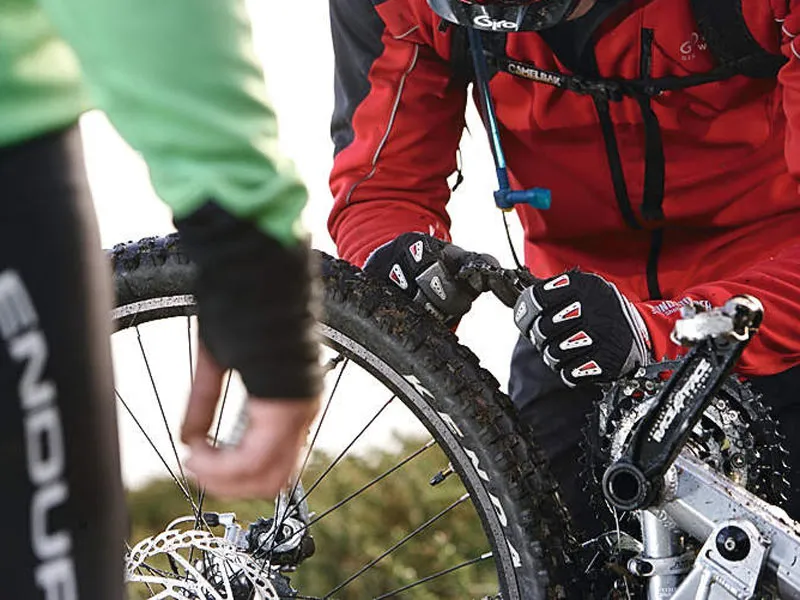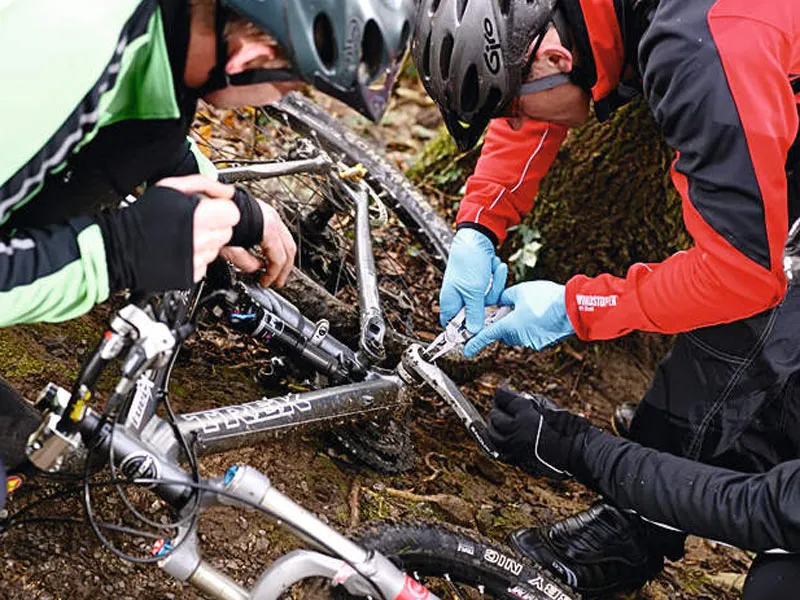Here we bring you expert tips and some neat fixes including how to fix a puncture without a new tube/patch, how to fix a torn tyre, how to fix a badly bent wheel without any tools, how to fix a bent or twisted tooth chainring, how to fix a jumping/stiff chain, how to fix a soft shock/fork, how to fix a lost bolt, how to fix a snapped frame and much more.
You’ve been staring out the window all week, the weather is perfect, all your best buddies are out and you’re riding your favourite flowing trail like a god. Next thing you know there’s a bang, a pop or a horrible grinding noise and you’re knackered. It’s not looking likely you’re going anywhere soon either, so all you can do is wave your mates off down that delicious descent as you have an attack of trailside Tourettes.
We know you love riding as much as we do, so we’re not going to leave you stuck like that if we can help it. Hell no, we’re going to show you how to fix a puncture without a tube or a patch, how to straighten a crisped wheel in a second and how to ride home even after your gears have been twisted in half. In fact, we’ll cover the 10 most likely things to go wrong and how to sort them.
Not only will you become your own ride rescuer, but you’ll be a superhero of the singletrack, saving damsels in distress and letting bent hoop huckers ride free. In fact, the only thing we won’t help you with is pulling your pants on over your shorts and finding a crashproof cape.

null
How to fix a puncture without a new tube/patch

Of course you took a spare tube for a rapid repair, but your fat mate has popped his tyre on a rock yet again, and none of your patches are big enough to cover the gaping hole.
Fear not my flaccid friend, simply slice the tube completely in half at the punctured bit and tie a really, really tight knot in both ends. Your new sausage tube will be a proper banger when you go over the knot, but go as steady as you can and it’ll get you home safe and sound.
The long term fix: Fit a new tube or patch the hole if you can.

null
How to fix a torn tyre

Flatted halfway through a rock garden or just got unlucky with a flint? Either way your tyre sidewall looks like it’s been knifed and it’s spilling its innertube guts out.
If the tube’s not popped yet, deflate it immediately before it does, then fish out some gaffer tape or a fiver – better still someone else’s fiver. Now carefully spread this handy rip-proof tyre patch over the inside of the gash and gradually pump the tube up to pressure, checking it stays in place.
The long term fix: It’s time for a new tyre we’re afraid.

null
How to fix a badly bent wheel without any tools

Flying always feels great, but the landings aren’t always so joyful. If your last launch or game of chicken with a drainage ditch has warped your wheel too much to fit through your frame, all is not lost.
Simply pull out the wheel and find the most bent bit on the rim. Check again to be sure you’re not actually bending the straight bit, then slam it sidewall down onto the floor. Real experts at this can do it in one mighty blow, but even truing a wheel with a few well aimed wallops will earn you big respect for your roundness restoration skills.
The long term fix: Even out spoke tension to true it properly when you get back.

null
How to fix a damaged beyond repair derailleur

Maybe it got knocked by a rock, maybe it bent in the car, or perhaps it was never adjusted properly. Whatever the cause, your cassette now has your rear mech in a full Nelson and something significant is badly bent.
Your first move is gentle reasoning. Coax the various pieces back into alignment with a pair of pliers or stout stick. If something’s snapped though, it’s time to go singlespeed. Start by removing the remains of the rear mech, looping the cable out of the way. Now shorten the chain so it fits as tight as possible round the middle ring and the smallest cog.
It’s not perfect, because modern cassettes try to ‘auto change’ the chain up the block and any suspension movement can slacken or tighten the chain, which can all end in seizing or snapping. But if you go steady it’s a lot faster and more fun than walking.
The long term fix: A new gear hanger and maybe a new mech – set up properly next time!

null
How to fix a bent or twisted tooth chainring

It’s not you that suffers if your log hop or trials skills aren’t as good as you thought, is it? No, it’s your poor innocent chainring teeth. Luckily, drivetrain dentistry involves nothing more than a pair of pliers or an adjustable spanner to straighten out any bent over teeth. If you’ve got time, filing off any flat spots or burrs will keep shifting smooth, too.
The long term fix: Bolt on a brand new chainring or consider a bash guard if it happens regularly.

null
How to fix a jumping/stiff chain

We love this one because it’s so simple. Unless your chain is old and worn, any mis-shifts, slips or skips are probably because of a stiff link. Simply find the stubborn specimen by backpedalling and watching for rear mech wobble, chain hop or an obvious kinked link. Now grab the offending stiffy on either side and flex it from side to side until it goes all floppy again.
The long term fix: Keep your chain well lubed and don’t leave it sitting ‘dry’ for ages.

null
How to fix a loose crankarm

You’re charging upwards to the summit or flowing through the jumps when suddenly your bike has done a Heather McCartney and you’re one pedal short of a pair.
Riding with a wonky crank will wreck the arm and the axle if it comes off completely – not to mention risking injuring yourself – but few of us carry a proper crank tool onto the trail.
Instead, find whatever you can to jam into the hole. We’ve remounted Hollowtech II cranks with the noses of pliers and even refitted loose Hussefelts with carefully whittled sticks, but whatever you use, keep it handy because the chances are you’ll be needing it regularly until you get home.
The long term fix: Get a proper crank tool/correct Allen keys and keep them in your bag for next time.

null
How to fix a soft shock/fork

One minute you’re floating as smooth as the rolling sea, next minute you’re going down by the bows or smacking your pedals on the floor. A blown air shock is often terminal, but it might just be ‘stuck down’.
Check by letting all the air out and then compress the unit while ‘burping’ out any excess or trapped wind through the valve. Now inflate to pressure and off you go again.
A bit of grit in a valve or fork top can create a gradual or sudden leak, too. Only start playing ‘pull everything apart’ if you’ve got tools that can do it properly without mangling delicate alloys. If that’s a yes, deflate the unit completely, clean the valve, seal threads and then reinstall with your fingers crossed.
The long term fix: Shock problems are best dealt with by proper specialists such as Mojo or TFT.

null
How to fix a lost bolt

Vibration from a rough trail can shake out even the most secure bolts and scatter them as shrapnel along the singletrack. Some – like RockShox rebound adaptors – should be taken out as a matter of course, but losing a brake, stem or seatpost bolt can turn you from a rider to a rambler without warning.
If you’re smart, you’ll have spares of the vital bolts in your rescue pack, but if not, start scavenging bolts from less essential bits of your bike. Bottle cage bolts will often fit stem fronts or brake clamps, while seatpost bolts will sometimes reattach your brakes if you don’t mind standing up all the way home. Even using a ziptie to keep something at least vaguely attached is often better than no bolt at all.
The long term fix: Check the threads are OK and consider a dab of Loctite, but otherwise just bung a new bolt back in.

null
How to fix a snapped frame

You’re just having ‘one last run’ down the descent or dirt park, but it’s the final straw for your frame as metal fatigue turns to fracture. That almost always means it’s time to start walking while working out how to pay for a new one. The potential consequences of a splinted maintube, stem or handlebar snapping are too dangerous to even consider, but lashing a stick or strip of metal around a partially cracked chain or seatstay might get you out of the middle of nowhere before dark or home in time for a hot date. Don’t even think about going out on it again if you do limp home though.
The long term fix: Any sort of chassis crack means it’s time to check your warranty or work out what frame you want next.
Urban Myths
No top tips feature would be complete without a section of bloopers and urban myths that have been passed down by those who’ve never tried them. Well, we can tell you we have tried these five classics and now you don’t have to bother!
- THE MYTH: You can splice a gear cable with a ring pull.
- THE TRUTH: You can’t – the knots never hold and tabs don’t even come off cans any more.
- THE MYTH: You can make brake blocks out of leather or old car brakes.
- THE TRUTH: You could with Raleigh Rainchecks in the 70s and Pro Stops in the 90s, but not any more.
- THE MYTH: Putting sticks inside your broken handlebars will keep them going longer.
- THE TRUTH: Soft wood that’s thin enough to fit inside your bars and has already snapped off a tree is not going to be stronger than a handlebar that you’ve already broken once.
- THE MYTH: Putting a stick or a rod inside blown forks will keep them at ride height.
- THE TRUTH: You know what, if you’re that daft you deserve the untold damage to delicate internal surfaces and structural failure putting loads in all the wrong places that this practice will cause.
- THE MYTH: Filling tyres with grass will fix a puncture.
- THE TRUTH: Even if you puncture in a meadow on the first lap of a 24hr race, there’s no way you’ll have harvested enough hay to approximate an innertube by the time it finishes.

